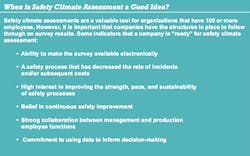Does your company have a strong emphasis on safety but a poor safety climate? Do you have all the right bells and whistles – programs, protocols, processes – but does your safety program break down as production demands rise?
“Companies often don’t become aware of a safety problem until an accident occurs, when it is too late. Safety climate, properly assessed, can help companies recognize and address emerging problems before accidents happen,” said Yueng-Hsiang (Emily) Huang, Ph.D., an organizational psychologist and lead safety climate researcher at the Liberty Mutual Research Institute for Safety (LMRIS). “Our safety climate research initiative provides the science behind this more proactive approach to safety that does not replace, but builds on, traditional engineering and design approaches.”
Safety climate – your employees’ shared perception of the priority of safety in your organization – is the only measurable leading indicator of your safety culture. According to an article published in the latest issue of Liberty Mutual's From Research to Reality, scientifically designed safety climate surveys can help company leaders assess how employees practice safety on a day-to-day basis when faced with competing demands such as production and delivery deadlines.
“Most companies profess a commitment to safety that is sincere,” said Marvin Dainoff, Ph.D., director of the Liberty Mutual Research Institute for Safety (LMRIS) Center for Behavioral Sciences. “But carrying out that commitment on a daily basis is a complex challenge. Safety climate assessment surveys measure how a company is or isn’t meeting that challenge and provide a solid point of reference for making safety improvements.”
The researchers at LMRIS developed a study that focuses on lone workers, workers who performed their jobs away from co-workers or supervisors. Workers at trucking and utility companies were chosen to participate, and researchers recruited 10 companies. Said Huang, “We wanted to know if safety climate could predict injury even among those who work in relative isolation. In other words, does safety climate have an impact when no one is looking?”
In 2010, researchers administered the lone worker safety climate surveys to more than 9,000 drivers and supervisors employed at eight trucking companies. In 2011, researchers surveyed more than 2,400 utility workers and supervisors from two utility companies. Each participating company also provided researchers with injury frequency and severity data.
Researchers found a “significant association” between the safety climate scores and injury data for both the trucking and utility companies, said Huang. “This showed us that, even among lone workers, safety climate is a valid predictor of safety outcomes,” she added.
The LMRIS research also found a disconnect between the safety climate scores of supervisors and those of employees, which raises questions about organizational dynamics.
“The data showed that supervisors consistently score safety climate higher than workers do, and that their responses are not predictive of safety outcomes,” Huang explained.
Huang believes that determining why supervisors perceive safety climate more favorably than workers and discovering how supervisors can become more attuned to workers’ perceptions of safety climate requires more in-depth exploration.
“The answers will help shape future safety climate research,” she explained.


